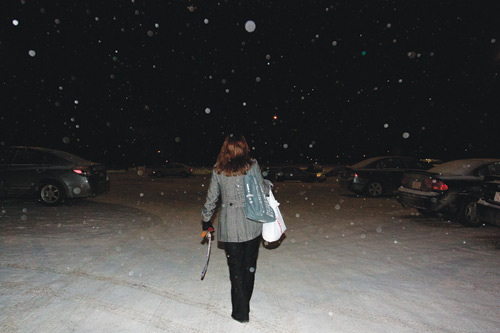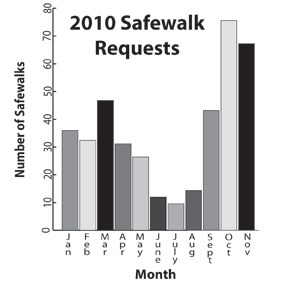Stats suggest Safewalk program underused

Photo by Rachael Frey. According to stats from Campus Security, 281 Safewalks were requested in 2010, an average of 23 walks per month.
by Rachael Frey
The Reflector
Daily exercise may be an important part of staying healthy, but it shouldn’t include a fearful sprint to your car after the sun goes down.
Statistics from the 2010 National College Health Assessment suggest that over 60 per cent of Mount Royal students have felt less than safe on campus after dark, yet nowhere near that number are using the campus’ Safewalk service.
“I knew that the service was available, but I guess it was an instant gratification thing, like I was ready to leave right then and they weren’t immediately there and going my way,” said Vanessa Oakley, a former theatre arts student. Though she never called Safewalk, Oakley said she did not always feel safe walking alone after dark. “There were times when it was pretty sketchy and I basically ran to my car,” she said. “Mostly, I tried to always park as close to the school as possible and I would walk with a friend from my program.”
Penny Thompson, another former theatre arts student, said she never used Safewalk either, because she
was usually with someone else or had a ride waiting to pick her up. The times that she was alone, she did not feel that she was in danger.
“I always felt pretty safe,” Thompson said. Anyone on campus (students, faculty, staff and visitors) can call and request an escort to walk with them to their vehicle or bus stop.
However, Mount Royal security statistics show that 281 Safewalks were requested in 2010, an average of about 23 walks per month.
Rahul Bali, Safewalk administrator, said that the campus’ level of safety is very high and that preventative measures such as Safewalk and security patrols contribute to keeping it that way.
“Our campus security is amazing, they have cameras everywhere, they’re doing bike patrols, they’re doing patrols in the truck and all that kind of jazz, and that makes people feel safe,” said Bali.
The number of people who use the service may be low in relation to the university’s population, but requests for the service have actually increased dramatically over the last semester. Bali attributes the increase to more promotion and growing awareness.
And while the majority of Safewalk users are female students, Bali said there’s also been an increase in the number of males, staff and faculty that are using it.
“Risk can be for anybody,” he said. “You can never be too safe.”
Bali also pointed out that staying safe is not just a matter of worrying about someone leaping out of the shadows at you. “It might not be that someone’s attacking you, but that you’re walking alone in -35 degree weather and slip on the ice and can’t get help right away,” he said.
While riskier situations are handled by campus security, Bali said he’s confident that his volunteers have the training and know-how to deal with any issues that come their way.
“We do give physical training and we have radios, so if somebody is crossing that line then something will happen.”
To request a Safewalk escort, drop by the security desk near the West Gate entrance, or use one of the red emergency phones around campus to get a direct connection.




